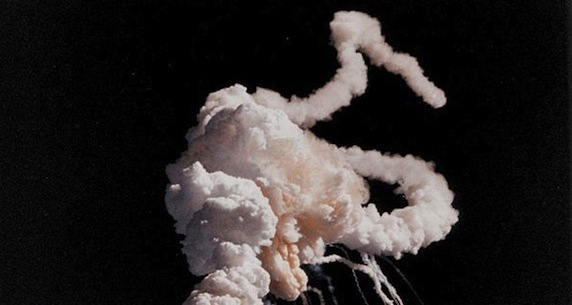In less than two weeks we will quietly pass the 27th anniversary of the space shuttle Challenger disaster-an unnecessary tragedy that cost the lives of seven astronauts on a frosty January morning in 1986. I was lucky enough this week to sit through a talk given by a former employee of Morton Thiokol-the company who manufactured the boosters used on and widely blamed for the Challenger disaster.
The commonly accepted explanation for the accident was that Thiokol’s booster design contained fatal flaws in the O-rings that held the boosters together, and coupled with poor organizational control that prevented the flaws from being addressed. The truth, however, was much greater, and much more troubling to anyone who believed in the greatness of the American space program or the infallible nature of President Ronald Reagan’s administration.
To truly understand the roots of the Challenger tragedy, it’s important to look at the political culture and relevant history of the space shuttle program that put seven astronauts lives at risk in January 1986.
It begins with the award of the contract for the shuttle’s solid rocket boosters to Morton Thiokol in late 1973. Telling about the agency’s attitude toward contracting support is that, during the procurement process, MT was scored third out of four in technical competency, but came through as the lowest cost vendor, leading to their selection for the project. Remember, this was for the two rockets that provided the initial boost to lift the shuttle and over 1-million pounds of liquid fuel from the launch pad, making it the perfect candidate for the Wal-Mart approach.
What allowed MT to keep costs low for their estimates was their reliance on building the boosters in Utah, where the labor force was deemed to be much more cost effective (because, honestly, who wants to live in 1970s Utah?). Further, it was determined that the boosters would be constructed in a way to allow them to be reusable, meaning parts that were stressed by the extreme conditions of hurling the shuttle into low-earth orbit and plunging down to the ocean would be used again and again. The real savings, though, came from MT’s decision to ship the boosters to NASA by rail, meaning that the design was constrained by what could fit on a commercial rail car. That’s how you get a multi-sectional rocket booster and thus, O-rings.
Fast forward 11 years to the Presidential election year of 1984. In a not-particularly-difficult campaign against Walter Mondale, the Reagan campaign found itself branded as ‘anti-education’ and ‘anti-teacher’, which, nearly 30 years later, should shock exactly no-one. The Reagan response? The Teacher in Space Program. Take a teacher (Christa McAuliffe, in this case), train them as an astronaut, slap them in a space shuttle (which, by the way, you’ve also proposed to use as a transport system to put missile defense systems in space), and away we go! Military? Good. Space program? Good. Add a teacher? PR goldmine. Suck it, Mondale.
Meanwhile, over that time, the Space Shuttle had been flying and NASA and MT were learning lessons about what worked and what didn’t. One thing that had been exposed was that the rubber O-rings were especially susceptible to cold, as was to be expected from a compound whose properties include weakening when put into cold conditions. This was especially troubling for a component whose function was to flex to fill the space between the booster segments as they became stressed by firing the solid fuel contained with in. In an over-simplification: If the seals weren’t sound enough to expand and fill the gaps, air from the outside would interact with the burning fuel in a way that could be catastrophic.
Bluntly put, none of MT’s testing was able to verify that the O-rings were safe for launch at temperatures under 40F. Tracking against launch temperatures in the 40s and 50s, MT engineers had found a correlation between stress and burn-through of the O-rings, but had not, at the time, been able to validate a mathematical equation proving such.
The initial launch for the Teacher in Space program was scheduled for January 25th, 1986. McAuliffe, along with six NASA astronauts, would travel to space and orbit the Earth for several days. That trip was to overlap with Reagan’s State of the Union speech on January 28th (later moved to February 4th). It was later revealed that Reagan intended to set up a communication link with the Challenger, so that he could speak to the astronauts (especially McAuliffe) during the address.
Initially, the launch was pushed back to January 27th due to weather, then again pushed to the 28th due to malfunctions with a sensor in the hatch door, which caused enough delays that dangerous wind patterns forced a full scrub of the planned launch. What would follow from the time of the January 27th postponement to the investigation afterwards would make Tom Clancy (or Oliver North) blush.
This is part one in a two part series exploring the Challenger disaster. Stay tuned for part two.
Image: Wikimedia Foundation
